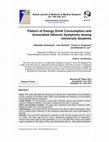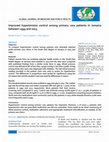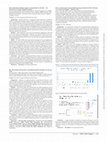Papers by Trevor Ferguson

F1000Research
Background Excess dietary salt consumption is a major contributor to hypertension and cardiovascu... more Background Excess dietary salt consumption is a major contributor to hypertension and cardiovascular disease. Public education programs on the dangers of high salt intake, and population level interventions to reduce the salt content in foods are possible strategies to address this problem. In Jamaica, there are limited data on the levels of salt consumption and the population’s knowledge and practices with regards to salt consumption. This study therefore aims to obtain baseline data on salt consumption, salt content in foods sold in restaurants, and evaluate knowledge, attitudes, and practices of Jamaicans regarding salt consumption. Methods The study is divided into four components. Component 1 will be a secondary analysis of data on urinary sodium from spot urine samples collected as part of a national survey, the Jamaica Health and Lifestyle Survey 2016-2017. Component 2 will be a survey of chain and non-chain restaurants in Jamaica, to estimate the sodium content of foods sold...

ABSTRACTBackgroundFaster growth velocity during childhood may increase blood pressure (BP) in adu... more ABSTRACTBackgroundFaster growth velocity during childhood may increase blood pressure (BP) in adults, but there are little data from African-origin populations. We evaluated the effect of postnatal linear growth (increase in height) and change in body mass index (BMI) from birth to adolescence on systolic and diastolic blood pressure (SBP and DBP) in Afro-Caribbean youth.MethodsWe used data from the Vulnerable Windows Birth Cohort Study in Jamaica. Children were followed from birth, with periodic anthropometric measurements. BP measurements started at age 1-year and every six months thereafter. Analyses used BP measurements (mmHg) from age 15-21 years. Linear growth and change in BMI measurements were calculated for: early infancy (0-6 months), late infancy (6 months - 2 years), early childhood (2-8 years), and later childhood (8-15 years). Conditional analyses were used to compute growth rates (as z-scores). Linear mixed models were used to estimate the effect of growth rates on BP...
Search strategy. A detailed description of the search strategy and databases searched to identify... more Search strategy. A detailed description of the search strategy and databases searched to identify relevant papers for inclusion in this systematic literature review. (DOCX 21 kb)
Search and Data Extraction Strategy (DOCX 26 kb)
Open Forum Infectious Diseases, 2015

Objectives: To estimate the prevalence of diabetic foot complications among patients at the Unive... more Objectives: To estimate the prevalence of diabetic foot complications among patients at the University Hospital of the West Indies (UHWI) diabetes clinic and identify factors associated with these complications. Methods: A stratified random sample of 188 patients were interviewed and examined between 2009 and 2010. Trained research nurses obtained data on self-reported foot complications, measured anthropometrics and performed foot examinations - including assessment for amputations, ulcers or foot infections, pain perception, vibration perception and pressure perception using monofilament, and peripheral vascular disease by ankle brachial index. Diabetes control was assessed using a point-of-care HbA1c test. Results: Participants included 143 women and 45 men with mean age of 56 years and mean diabetes duration of 16 years. The prevalence of amputations was 8.5% (95% CI 4.5-12.5%) and was higher among men (22.2%) compared to women (4.2%); p<0.05. There was no sex difference in t...
Current Cardiovascular Risk Reports, 2010
The epidemiology of cardiovascular disease in the black population of the Caribbean is important ... more The epidemiology of cardiovascular disease in the black population of the Caribbean is important as attempts are made to understand the reasons for racial disparities in health outcomes in developed countries. Over the past 50 years, the Afro-Caribbean population (ie, Caribbean people of African descent) has undergone an epidemiologic transition, with cardiovascular disease now ranked as the leading cause of death

Journal of Clinical Epidemiology, 2015
To investigate cost savings from and implications of replacing the single risk with a total cardi... more To investigate cost savings from and implications of replacing the single risk with a total cardiovascular risk approach in primary prevention of cardiovascular disease (CVD). A cost analysis using data from the 2007-08 Jamaica Health and Lifestyle Survey of 1,432 persons aged 40 years and older with 10-year risk estimated from region-specific World Health Organization/International Society for Hypertension (WHO/ISH) CVD risk charts. The WHO/ISH and local treatment guidelines were used to cost lifestyle changes, medications, and provider visits. Use of the total cardiovascular risk approach was less costly regardless of age. Women showed greater cost disparity. However, if 10-year CVD risk was estimated without measured cholesterol, both approaches resulted in similar costs in men ≥60 years. The annual per capita cost of lifestyle recommendations, critical in the absence of pharmacotherapy, was estimated at US $869.05 for diet and US $80 for physical activity. This represents about a third of the annual income of a minimum wage earner. At the national level, implementation of the WHO/ISH total risk approach could reduce health care costs by US $5 million annually. Cost savings that mainly resulted from reduced care for women may lead to gender disparity in CVD outcomes.

British Journal of Medicine and Medical Research, 2013
Aims: This study estimated the prevalence of energy drink consumption among students at the Unive... more Aims: This study estimated the prevalence of energy drink consumption among students at the University of the West Indies (UWI), and describes the frequency of consumption and associated adverse symptoms. Study Design: A cross-sectional survey was conducted using a sex-stratified random sample of students residing in the halls of residence at the UWI, in Jamaica. Place and Duration of Study: The study was conducted at the Mona campus of UWI, between October 2011 and January 2012. Methodology: A self-administered questionnaire was used to obtain demographic data, use of energy drinks, frequency of use, symptoms associated with use and perception of benefits. Results: There were 607 participants, consisting of 336 (55.4%) females and 271 (44.6 %) males. The mean age was 20.7 years. Jamaicans constituted 80% of responders. Energy drinks were used by 450 participants (74.1%), with 288 (64%) being once weekly users, consisting of 160 males (74.8%) and 128 females (54.2%). There were 20 students

Clinical Endocrinology, 2014
Context Early-life factors (including intrauterine growth retardation) may influence the developm... more Context Early-life factors (including intrauterine growth retardation) may influence the development of type 2 diabetes. We postulated that birth size is associated with cortisol levels, which itself could alter serum adipomyokines (i.e. adiponectin, IGF-I, myostatin) and glucose metabolism. Design An observational study with 60 Afro-Caribbean young adults from a birth cohort. Measurements Fasting blood was drawn for serum adiponectin, IGF-I and myostatin. A frequently sampled intravenous glucose tolerance test measured insulin sensitivity (SI), acute insulin response (AIRg), disposition index (DI) and glucose effectiveness (Sg). Body composition was assessed by dual-energy X-ray absorptiometry. Salivary cortisol was collected at home at 0800 and 2300 h. Sex-adjusted correlations were used to explore the relationships between birth size, cortisol and the metabolic variables. Results The participants were 55% male, mean age 23Á1 AE 0Á5 years. Birth weight correlated positively with 2300-h cortisol (P = 0Á04), although not after adjusting for gestational age. Gestational age was correlated with 2300 h cortisol (r = 0Á38, P = 0Á03), even after adjusting for birth weight (P = 0Á02). 2300 h cortisol was not associated with adiponectin, IGF-I, myostatin, SI, AIRg or DI, but was negatively correlated with Sg (r = À0Á30, P = 0Á05) even after adjusting for birth and adult anthropometry. Adiponectin, IGF-I and myostatin were unrelated to glucose metabolism. Conclusions Gestational age is associated with higher nocturnal cortisol, which in turn is associated with lower glucose effectiveness in adulthood. Higher glucose effectiveness could therefore be a compensatory mechanism to improve glucose uptake.

Journal of Clinical Densitometry, 2008
Quality of DXA testing is related in part to machine performance, to operator, to interpreter com... more Quality of DXA testing is related in part to machine performance, to operator, to interpreter competence. Operators are encouraged to scan phantoms daily, to plot the results graphically for visual assessment, then to apply statistical tests such as Cusum s and Shewhart s rules, mostly applied retrospectively. We studied 6 systems (3 GE and 3 Hologic) in the US, Canada, and Switzerland. We applied Med-Imaps software to phantom data obtained from 1996 to nowadays. The software analyzed phantom data and generated a report of all violations of statistical rules. We estimated the length of time patients might have been exposed to an unstable system using traditional QC. We assumed that the Med-Imaps QC, if used in an automatic daily fashion, would result in restoration of system stability after one day. We then compared the duration of system instability using traditional QC to the time of exposure likely from automated software. We found violations 1015 days over 217 months for 2 systems yet analyzed. There was a large variability in system stability for example with HOLOGIC1 having 0 unusable day and HOLOGIC2 having 3 majors periods of unstabilities detected (Shewhart s rules). In aggregate, this may expose patients to a system with suboptimal QC for 523 days; with semi-automated software this would result in (estimated) 140 days of suboptimal QC testing. We conclude that instrument QC using traditional methods is suboptimal. Live, daily, automated QC would provide an opportunity to reduce the exposure of patients to DXA systems generating unreliable test results.

ABSTRACT The inclusion of epidemiology and biostatistics in the undergraduate medical curriculum ... more ABSTRACT The inclusion of epidemiology and biostatistics in the undergraduate medical curriculum is essential in this era of evidence based health care. Despite this, teaching this topic often results in the students feeling confused and the teachers discouraged. At The University of the West Indies, Mona, Jamaica, students in the first semester of their third year are routinely asked to complete an evaluation form at the end of an introductory course in epidemiology and biostatistics. Students’ views on course content and instructional strategies for the year 2009 are presented here. The majority of students reported that the material presented was useful in helping them to interpret or carry out research in the future. They reported marked improvement in their ability to read, understand and critique the medical literature. Lectures were considered to be the most effective instructional method overall but less than one fifth of students thought biostatistics was effectively taught through that method. Students seemed to favour a teacher-centred learning environment although an appreciation for certain features of a learner-centred approach, such as participation in student led group presentations, was evident. We conclude that a combination of instructional methods is useful to teaching epidemiology and biostatistics to medical students. It is necessary to identify the unique features of the different approaches that make them beneficial and use this information to better design teaching/learning programmes, with special consideration for the specific subject area being addressed. An enabling environment, including suitable teaching staff and infrastructure that actively engages learners using a variety of approaches, is essential to the teaching/learning process for epidemiology and biostatistics. Application of the principles taught in this course during their clinical rotations will also help to consolidate the learning experience.
The West Indian medical journal, 2012

Objective To compare hypertension control among patients who attended selected public primary car... more Objective To compare hypertension control among patients who attended selected public primary care clinics in the South East Region of Jamaica in 2013 and 1995. Methods Patient records from six randomly selected health centers in the South East Health Region of Jamaica were audited in 2013 and the data were compared with published findings from a similar study done in 1995. Blood pressure control was defined as BP of less than 140/90 mmHg or less than 130/80 mmHg among those who were also diagnosed with diabetes. The last blood pressure reading recorded in the patient chart was used to assess for hypertension control. The differences in proportions were tested for significance using the chi-square test and the student t test was used for differences in means. Results Five hundred patient records were audited in 1995 and 469 in 2013. The median age was 60 and 65 years and males comprised 18% and 35% (p < 0.001) of the patients in 1995 and 2013 respectively. More patients had their...

Open Forum Infectious Diseases, 2021
Background Despite advances in occupational safety protocols in healthcare facilities, needle sti... more Background Despite advances in occupational safety protocols in healthcare facilities, needle stick and sharps injuries (NSSIs) continue to be a concerning occurrence among healthcare workers (HCWs). Such exposures lead to the risk of blood borne infections as well as emotional and financial consequences which may be difficult to measure. Few studies on NSSIs among Jamaican HCWs have been published in the last decade. We evaluated adherence to established NSSIs management protocols and investigated the demographic and work-related characteristics of HCWs sustaining NSSIs. The proportion of HCWs affected and frequency and direct costs associated with these injuries were estimated. Methods This retrospective case-series reviewed HCWs employed or contracted to an urban tertiary teaching hospital in Jamaica, who reported NSSIs in the emergency room during the period January 1, 2015 and December 31, 2018. Archived incident reporting forms for these HCWs were reviewed. Data were analyzed ...
Artery Research, 2017
Conclusions: In hypertensive patients age appears to be the major determinant of TOD, with centra... more Conclusions: In hypertensive patients age appears to be the major determinant of TOD, with central SBP, and marginally peripheral SBP, PWV and AIx, also playing a significant role. Our results suggest that estimation of 24-hour central hemodynamics and arterial stiffness in ambulatory conditions may help improve the individualized assessment of the BP-associated TOD.

Open Forum Infectious Diseases, 2018
Background. Diabetic foot infections (DFIs) require complex medical care. At our hospital, a team... more Background. Diabetic foot infections (DFIs) require complex medical care. At our hospital, a team of Infectious Disease (ID) specialists assess all inpatients with DFIs and transition these patients (patients) to an outpatient clinic with an ID and Podiatrist team. Clinical pharmacists have now joined the team to provide diabetes (DM) medication management. The goal of this project is to demonstrate the need for DM care in a multidisciplinary limb-salvage clinic. Methods. We performed a retrospective chart review of patients seen in the ID clinic September 2014-June 2015. DM medication management was implemented in August 2017. During clinic visits, the DM care plan is assessed for medication therapy problems related to indication, efficacy, safety, and adherence for all new DFI patients. All findings and interventions are documented, discussed with the team and communicated to the patient's primary care provider. Patients are followed at each visit to assess response to the intervention. Results. Five hundred patients were seen in ID clinic in 2014-2015. One hundred twenty-three patients had DFIs. Ninety-four patients (76%) had uncontrolled DM defined as hemoglobin A1c (HbA1c) ≥7%. The mean baseline HbA1c was 10.13%. Fifty patients (41%) had an amputation prior to the initial clinic visit. Sixty-nine patients (56%) were reevaluated in clinic for recurrent DFI after clinic discharge with a mean time to revisit of 210 days. 54% of these patients developed infections in the opposite foot. Post-implementation, 30 patients were seen by clinical pharmacists between October 12, 2017 and April 26, 2018. All patients had uncontrolled DM with a mean baseline HbA1c of 9.85%. 20 patients (67%) had at least one amputation prior to the initial clinic visit. Twenty-eight patients (93%) had ≥1 medication therapy problem requiring pharmacist intervention. All patients required self-management education. There was a trend toward improved control of DM with an average HbA1c of 7.48% in the 13 patients returning for 3-month follow-up visits. Conclusion. All of our patients required pharmacist intervention to improve DM care. Incorporating DM management into the clinic visit was feasible and well received. A registered dietician has been added to the team to aid in DM management. We hypothesize that including DM management in a multidisciplinary approach to limb-salvage is an essential and effective way to manage DFI patients and may lead to reduced readmissions and amputations. Disclosures. All authors: No reported disclosures.








Uploads
Papers by Trevor Ferguson